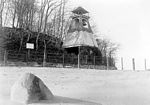Whitestone station
Former Long Island Rail Road stations in New York CityNew York City railway station stubsQueens, New York building and structure stubsRailway stations in Queens, New YorkRailway stations in the United States opened in 1869 ... and 2 more
Use mdy dates from July 2021Whitestone, Queens
Whitestone station was located on the Whitestone Branch of the Long Island Rail Road in Whitestone, in Queens of New York City. The station was located on 15th Avenue (which later became the eastbound service road on the Cross Island Parkway which ran on the Branch's Right-of-way) from 149th Street to 150th Street. It connected to the Whitestone Trolley. The station had a coal pocket underneath it and shipped some of it out.
Excerpt from the Wikipedia article Whitestone station (License: CC BY-SA 3.0, Authors).Whitestone station
Cross Island Parkway, New York Queens County
Geographical coordinates (GPS) Address Nearby Places Show on map
Geographical coordinates (GPS)
| Latitude | Longitude |
|---|---|
| N 40.787222222222 ° | E -73.814444444444 ° |
Address
Cross Island Parkway
Cross Island Parkway
11357 New York, Queens County
New York, United States
Open on Google Maps







